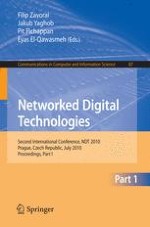On behalf of the NDT 2010 conference, the Program Committee and Charles University in Prague, Czech Republic, we welcome you to the proceedings of the Second International Conference on ‘Networked Digital Technologies’ (NDT 2010). The NDT 2010 conference explored new advances in digital and Web technology applications. It brought together researchers from various areas of computer and information sciences who addressed both theoretical and applied aspects of Web technology and Internet applications. We hope that the discussions and exchange of ideas that took place will contribute to advancements in the technology in the near future. The conference received 216 papers, out of which 85 were accepted, resulting in an acceptance rate of 39%. These accepted papers are authored by researchers from 34 countries covering many significant areas of Web applications. Each paper was evaluated by a minimum of two reviewers. Finally, we believe that the proceedings document the best research in the studied areas. We express our thanks to the Charles University in Prague, Springer, the authors and the organizers of the conference.
